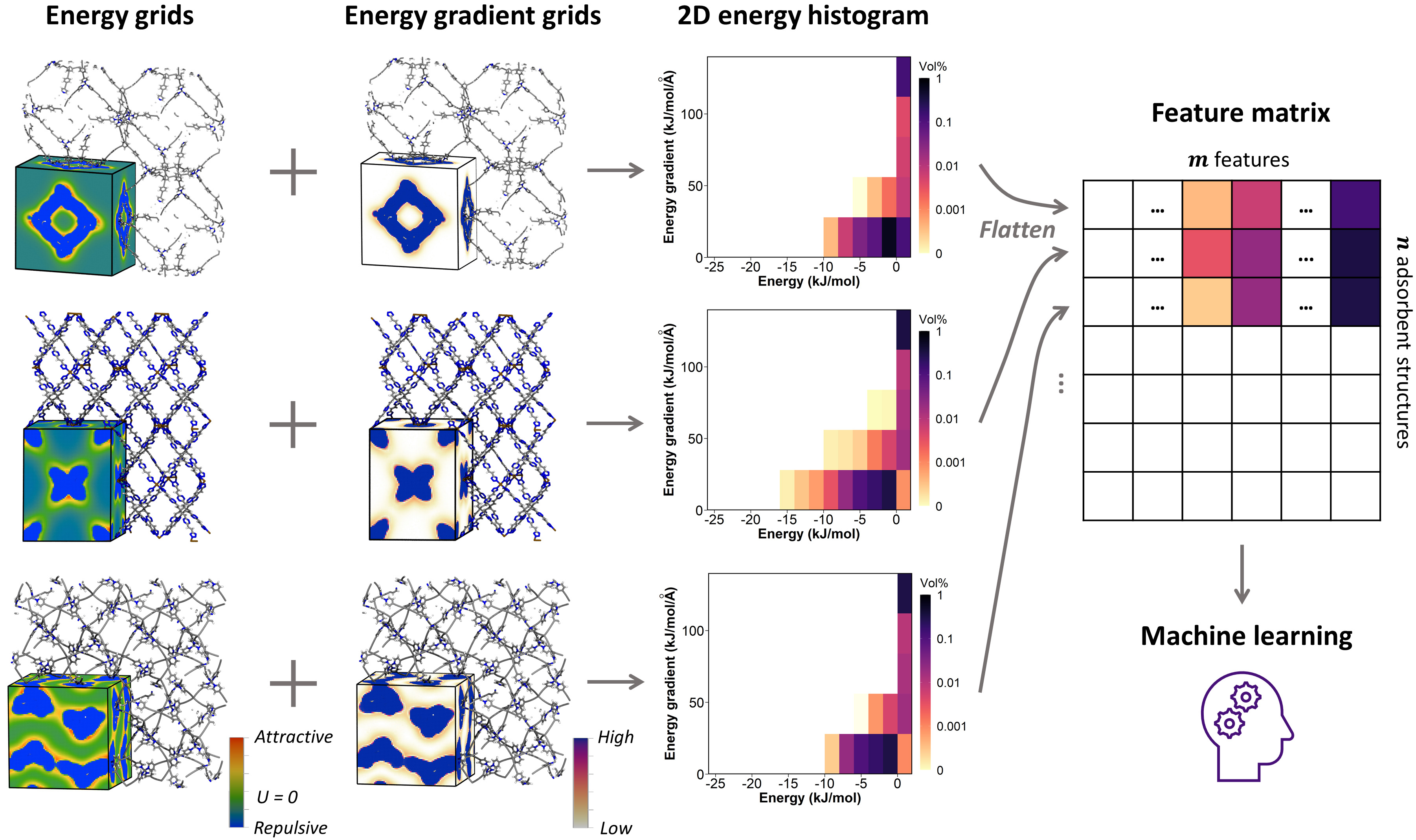My Research
I am a computational chemical engineer. My current research at Northwestern is focused on using quantum & molecular level simulations, machine learning, and mathematical models to understand molecular adsorption and transport in porous media, aiming to discover and design new nanoporous materials to address major societal problems in energy and sustainability.
Throughout my research career, I have initiated and engaged in many fruitful research collaborations with both theoretical and experimental groups. My research experience spans the fields of materials design and synthesis for adsorption and separation, interfacial phenomena, gene and drug delivery, nucleation, and nanocoating. For more information about these research topics, please refer to my previous publications. The following are my main research interests at Northwestern University and NC State University.
Novel Machine Learning Models for High-Throughput Screening of Metal-Organic Frameworks
My postdoctoral research at Northwestern University focuses on developing physics-inspired ways to represent nanoporous materials for machine learning (ML). Recently, I developed two-dimensional energy histogram features (or fingerprints) for ML to predict the adsorption capacity of a variety of molecules in metal-organic frameworks (MOFs). The idea was to let the ML model mimic how grand canonical Monte Carlo simulation works by converting probe-adsorbent energies and energy gradients into a format that is readable by ML algorithm and is invariant to the translation, rotation, and replication of material’s unit cell. In collaboration with Profs. David Sholl, Coray Colina, and Ilja Siepmann, we were able to extend our ML models to amorphous nanoporous materials (e.g., porous polymer, activated carbon, kerogen). This research allows us to precisely identify promising materials among hundreds and thousands of candidates within seconds, which is impossible for typical molecular simulations. One paper on this topic is in preparation.

Development and Management of an Open Online Adsorption Database
One initiative I took during my postdoc at Northwestern was to develop and manage a first-of-its-kind, freely available online adsorption database, MOFDB, in collaboration with many brilliant members in Prof. Snurr’s group. This database contains about 3 million simulation adsorption data points for over 160,000 MOFs (other porous materials such as zeolites will be added in the future). As of the end of 2021, this database has been accessed by over 3000 users from 65 countries. One paper on this topic is in preparation.

Microscopic Pressure Tensor in Thin Adsorbed Films
Motivated by high-pressure conducting materials formed in carbon nanotubes at ambient pressure, I applied molecular simulations and statistical mechanics to understand the physics behind strong compression and the induced high pressure (as high as tens of thousands of bars) in adsorbed layers. Microscopic pressure tensor plays a central role in describing the mechanical and thermodynamic states of inhomogeneous structures at the nanoscale. I showed, for the first time, that it is possible to uniquely define a microscopic pressure tensor, a property that had been considered ambiguous since the seminal work of Irving and Kirkwood in 1950. I developed a convenient way to estimate the tangential pressure in a direction parallel to the surface by a 2D equation of states, and also solved a serious barrier to the computation of the pressure tensor for molecules having long-range Coulombic interactions. The latter technical advance makes the calculation of the local pressure tensor possible in complex systems of practical interest, such as water confined in a nanotube. These collective efforts lay the foundation for the next-generation high-pressure manufacturing of pharmaceuticals and materials. See the following publications to learn more!
- K. Shi, E.E. Santiso, and K.E. Gubbins, "Can we define a unique microscopic pressure in inhomogeneous fluids?". Journal of Chemical Physics, 154 (2021) 084502. [link][PDF]
- K. Shi, Y. Shen, E.E. Santiso, K.E. Gubbins, "Microscopic Pressure Tensor in Cylindrical Geometry: Pressure of Water in a Carbon Nanotube". Journal of Chemical Theory and Computation, 16 (2020) 5548-5561. [link][PDF]
- K. Shi, K. Gu, Y. Shen, D. Srivastava, E.E. Santiso, K.E. Gubbins, “High-density equation of state for a two-dimensional Lennard-Jones solid”, Journal of Chemical Physics, 148 (2018) 174505. [link][PDF]
Molecular Modeling and Statistical Mechanics of Adsorption on Heterogeneous Surfaces
Adsorption on heterogeneous surfaces is ubiquitous in the real world. The complexity of the heterogeneous surfaces, however, prevents the development of more advanced and accurate adsorption theories. I developed an advanced statistical mechanical theory and a coarse-grained surface model for gas adsorption on geometrically and energetically heterogeneous surfaces. My development significantly simplifies the theoretical treatment of real heterogeneous surfaces without sacrificing model accuracy for predicting adsorption isotherm; it also paves the way for computational modeling of adsorption in larger temporal and spatial scales, which helps bridge the gap between computation and experiment.

See the following publications to learn more!
- K. Shi, E.E. Santiso and K.E. Gubbins, "Conformal Sites Theory for Adsorbed Films on Energetically Heterogeneous Surfaces", Langmuir, 36 (2020) 1822-1838. [link][PDF]
- K. Shi, E.E. Santiso, K.E. Gubbins, "Bottom-Up Approach to the Coarse-Grained Surface Model: Effective Solid–Fluid Potentials for Adsorption on Heterogeneous Surfaces", Langmuir, 35 (2019) 5975–5986. [link][PDF]